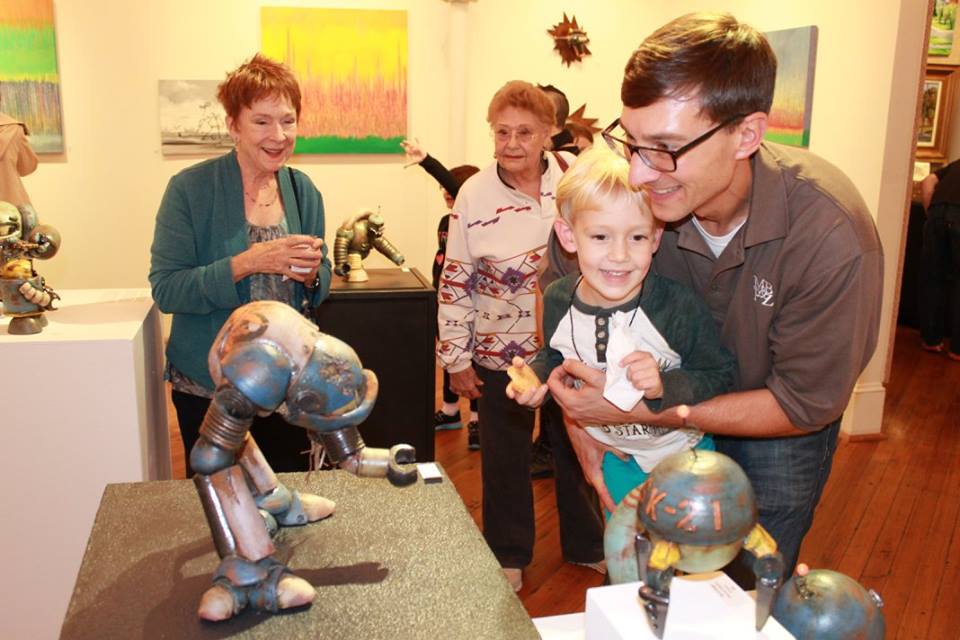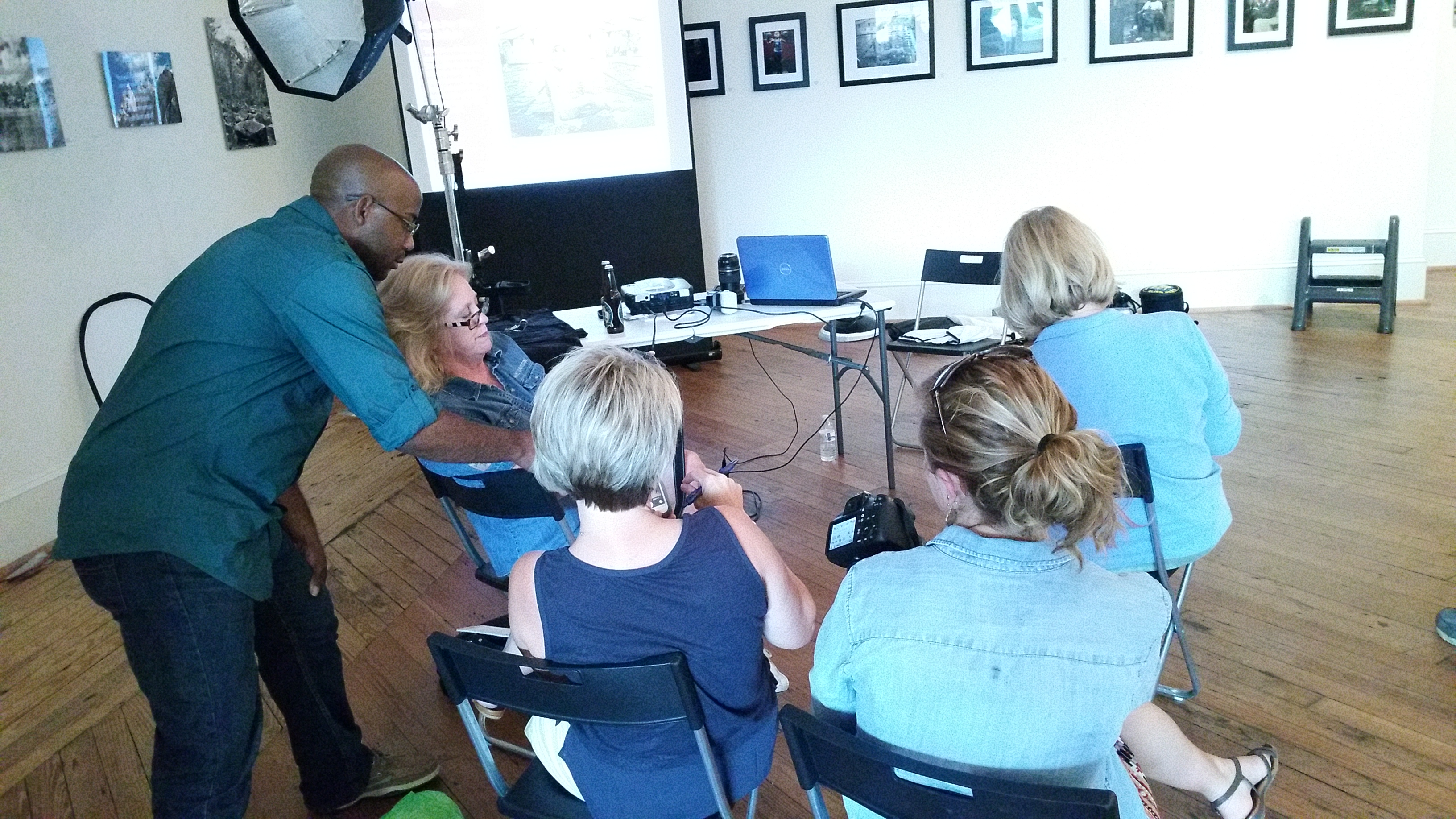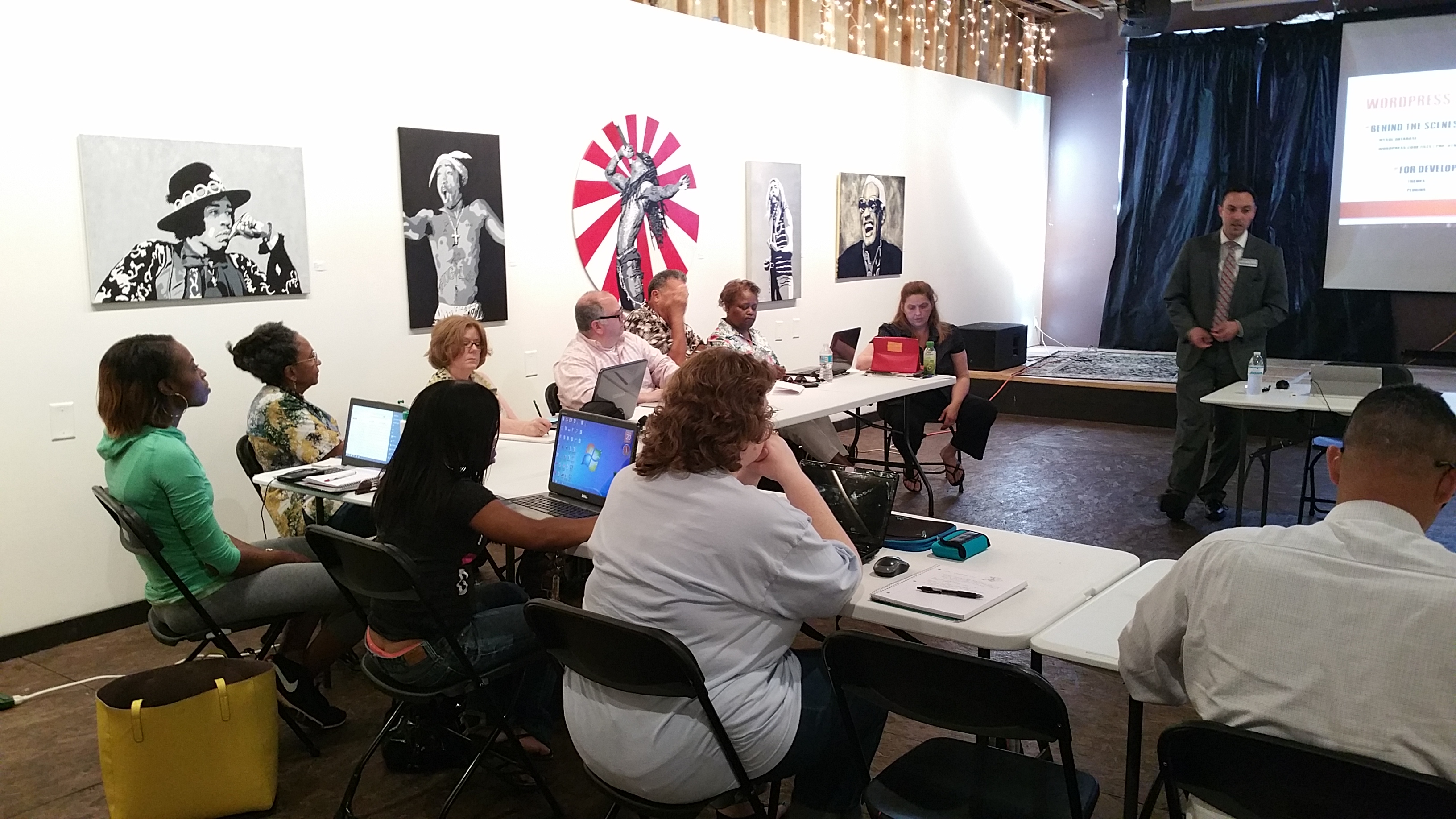
How the Macon Arts Alliance is leading through community transformation

Macon Arts Alliance Gallery. Photo courtesy of Stephanie Fritz.
This article is cross posted from Creative Exchange, the national program of Springboard for the Arts. It is part of a series of features on the members of the Leading Organizations pilot program, featuring organizations across the country working with artists in new and innovative ways. Learn more about all the organizations here.
Macon, Ga. is a city poised to transform. Sitting right in the middle of the state, Macon has been a transportation hub since before the Civil War. The town now boasts dozens of homes and neighborhoods on the National Register of Historic Places — the phrase “good bones” comes up frequently in writing about the city’s physical assets — but though it once was a prosperous center of the textile industry, it has suffered from urban decay for several decades.
“Macon has sort of the same issues as any post-industrial city of our size in America — issues of blight, issues of disinvestment in the neighborhoods that surround the urban core,” says Jonathan Harwell-Dye.
Harwell-Dye is director of creative placemaking at the Macon Arts Alliance, whose mission is to support and promote the arts and culture industry of Central Georgia. The Alliance was named the designated arts agency of the newly consolidated Macon-Bibb County in 2014, but the organization been around since 1984. It serves more than 60 arts organizations, plus the fine arts programs of five universities in the area.
“We’ve always been viewed as the unified voice of the arts community,” says Harwell-Dye. Despite that long-time role, the past few years have seen the Arts Alliance re-examining what its purpose should be. It used to re-grant state and local government funds to artists and organizations, says Harwell-Dye, but “all of the funding dried up about six years ago.” The loss has left the Alliance looking for new ways to serve the region.

Macon Arts Alliance Mill Hill. Photo by Jonathan Harwell-Dye.
One way it’s adapting is by exploring how the Arts Alliance can support revitalization and growth in the community, and seek out partnerships to help drive economic development.
“We were a manufacturing area for many years, and manufacturing is gone,” Harwell-Dye explains. “There’s a big push to be a logistics area, but we also have this really strong arts community. We’ve got 60 arts organizations that are part of our Arts Roundtable in a community of 155,000. We think that’s a really strong base to build on.”
A major new opportunity for the Arts Alliance came last July: The organization received an Our Town grant of $134,370 from National Endowment for the Arts for the initiative known as Mill Hill: East Macon Arts Village. The plan is to turn four square blocks of the Fort Hawkins/Main Street neighborhood, now suffering from blight and vacant spaces, into an arts-based destination.
The Mill Hill development is part of the Macon Action Plan, published in October 2015 as a community vision for the town’s urban core. The plan was put together by Macon-Bibb County, the Macon-Bibb Urban Development Authority, and their partners, and drew from surveys and public meetings conducted over more than a year.
Both the Macon Action Plan and the Mill Hill project are building off of downtown revitalization efforts that have already happened. The College Hill Corridor in downtown Macon has been home to a few notable developments in the past five years, including the Tattnall Square Center for the Arts, an abandoned former church transformed into a community center and a home for Mercer University’s theater program.

Matt Odom photographing an Amplify workshop. Photo courtesy of Stephanie Fritz.
Another recent success has been Beall’s Hill, one of Macon’s oldest and most racially and economically diverse neighborhoods. A partnership between the Historic Macon Foundation and the Knight Foundation has encouraged growth in Beall’s Hill through the renovation and new construction of homes.
For Mill Hill, drawing on the success of those earlier projects includes restoring architecture, developing a neighborhood park, and encouraging social change by bringing together residents with visiting artists.
The Mill Hill Visiting Social Practice Residency will ask artists to live in renovated homes in the area for three to nine months. Artists will work closely with their East Macon neighbors to develop programming that engages residents, including families and youth. Through the program, artists and long-term residents will collaborate on a creative assets map and cultural plan for the neighborhood.
“Always a big issue is, ‘Is this going to cause displacement?’” says Harwell-Dye. “We’ve been very intentional from the beginning to focus on vacant properties, a very small area, but also programmatic and policy solutions [to involve local residents].”
The project’s stakeholders are committed to keeping the area affordable using a community land trust, or CLT. The CLT model was started in Georgia as a way to maintain local control of land and assets. It works by establishing a nonprofit to own the land underneath a home, with a 99-year lease agreement between the CLT and the homeowner that ensures owner occupancy and responsible use. That lease rolls over to each new owner as the house is sold, so the affordability mechanism stays with the property and not the homeowner. Residents are still subject to property taxes for the home itself, but not the land, making them less likely to be priced out by rising taxes. The CLT system keeps homes on the tax rolls while making sure properties stay affordable long-term.
The Mill Hill project’s leaders are looking for other ways to keep housing affordable, too, including working with major employers in the area to provide down payment assistance for their employees.
“There’s no silver bullet. This is a strategy that will mitigate [displacement], but I don’t think it’s the only solution,” says Harwell-Dye. What’s most important, he says, is “the process of being asset-based and listening and collaborating with existing residents in the community, and of this long-term engagement where residents are at the table, but also positioned to be leaders as we execute the plan. The process is equity as much as the outcomes are equity.”

Nick Kouloungis’ WordPress Basics class. Photo courtesy the 567 Center for Renewal.
To build relationships and make sure residents are heard, the Arts Alliance is working with the Macon Roving Listeners. The group, started by Centenary Community Ministries, is designed to discover people’s gifts through listening. Youth and adults, some of whom have developmental disabilities, visit community members’ homes to learn about them — their passions, their talents, what they hope for their neighborhood.
The Roving Listeners call attention to the assets a community already has, says Harwell-Dye: “What can we learn from a neighbor instead of bringing in someone from the outside?”
Those discoveries, he says, might point to a better direction for the project than had previously been imagined. For example, the Urban Development Authority was planning to build a gateway park between the neighborhood and the Ocmulgee National Monument, a historic site with Native American ceremonial earth mounds. Once local residents were involved in the plan, the park shifted to be more neighborhood-focused, with pedestrian and bike paths leading to the monument.
At the beginning of this year, the Arts Alliance announced funding for a central feature of the planned arts village. The Old Bibb Mill Manufacturing Auditorium was built in the 1920s, and has since fallen into disrepair and disuse. The Community Foundation of Central Georgia awarded the Arts Alliance a challenge grant of $211,000 from an anonymous donor, and county commissioners met the challenge with blight bond funds. The restoration of the auditorium into an active performance and community space is already underway.
“We feel the auditorium is going to be the catalyst for the rest of the project,” says Harwell-Dye. “The artists’ live-work space is adjacent to the auditorium, so that will be a place where artists and community members can collaborate. That’s really the vision for that space.”
Downtown Macon’s revitalization will be propelled even further by the Downtown Challenge, also announced in January 2016. The challenge is a $3 million initiative, with two grant cycles a year for three years, and is a partnership between the Community Foundation of Central Georgia, the Peyton Anderson Foundation, and the Knight Foundation. It will fund ideas from the community — individuals, businesses, nonprofits — to help implement the Macon Action Plan.
The Arts Alliance is eager to support artists, arts organizations, and residents of the Mill Hill area in applying for Downtown Challenge funding, says Harwell-Dye. The Alliance can act as a sponsoring partner for individuals and grassroots organizations submitting their ideas.
Beyond their creative placemaking work, the Macon Arts Alliance acts as a leader for the region through the Arts Roundtable. This coalition’s 63 members include “everything from our local museums to grassroots arts organizations with an all-volunteer staff,” says Harwell-Dye.
The Arts Alliance leads the Roundtable by providing collaboration and professional development opportunities for its members, managing a community calendar, and advocating for arts and culture at a policy level.
That policy work is largely focused around an Arts Advocacy Breakfast, in which the Roundtable comes together on the issue they plan to tackle that year. The annual breakfast came out of Roundtable members’ desire for more of a voice in local and regional decisions. “A big issue in the past few years has been advocating for a seat at the table so we can have a bigger impact in the community,” says Harwell-Dye.
In addition to working with the region’s arts organizations, the Arts Alliance also provides resources for the individual artists of the community. The Amplify program launched in 2014 to support creative professionals with career resources and training.
From the beginning, Amplify has been the work of Stephanie Fritz, the Arts Alliance’s director of programs. After initially joining the Alliance as an intern, Fritz was hired full-time to head up the professional development program and determine how it would work.
She started by assessing the state of the arts in Central Georgia: what the community looked like and what the artists needed. This first phase of the project involved identifying and interviewing the region’s creative professionals through surveys and focus groups.
From there, the Arts Alliance developed the programs that make up Amplify: workshops and video tutorials to equip arts entrepreneurs to succeed in their careers. Amplify trainings cover general topics, such as time management, and specific ones, like tax preparation or using Etsy to sell work.
Amplify’s latest workshop focuses on portfolio building for visual artists, and on the skills involved in getting work shown in a gallery. The training was suggested and is taught by Beth Smith, who is both an artist and a curator at Macon’s 567 Center for Renewal, and offers information on developing both online and physical portfolios.
“The idea is coming straight from an artist who’s been very successful, so we’re excited to bring on this workshop,” Fritz says.
Besides Amplify, Fritz also manages another key Arts Alliance program: the art gallery that occupies the storefront of the Alliance’s office. It’s actually a pair of galleries — a boutique entrance space with items for sale from about 200 local or locally connected artists, and a back gallery that focuses on specific solo or group shows. The back gallery hosts a new exhibition each month, with an opening reception during downtown Macon’s First Friday event.
“Without a doubt, it’s one of the things we’re most known for in the community,” Harwell-Dye says. “People recognize the Arts Alliance because of that gallery.”
Art sales represent nearly half of the Alliance’s operating budget, but the organization also makes it a priority to pay artists through commissions. The gallery’s biggest annual event is Fired Works, the largest pottery and ceramics exhibit in Georgia. In 2015, the 10-day showcase yielded $89,500 in pottery sales, and the Alliance paid out more than $50,000 in artist commissions.
Because of that ability to directly support artists while providing earned income, the Arts Alliance sees the gallery as a model other organizations will want to follow. So they’re turning it into a toolkit.
The storefront gallery kit will become available this year through the Arts Alliance’s participation in the Leading Organizations pilot program, alongside agencies from Nashville, Pittsburgh, San Jose, and St. Paul.
Though the gallery has existed in some form for a decade, creating the toolkit has helped the Arts Alliance think through how and why it works. Running a gallery involves both art curation and business management — not only seeking out artists and determining what will be shown, but also figuring out details like a point-of-sale system and how to market the gallery. Both Fritz and Harwell-Dye emphasize that building relationships with the artists is essential.
“You have to know and have a feel for the local arts community, what it’s doing and the kind of work that’s being produced, and also the market and what motivates buyers in this area in terms of purchasing art,” Harwell-Dye says. “You have to get into the rhythm of your community as much as anything.”
He also cites the First Friday gallery crawl as a driver of traffic and attention to the space. “A lot of our sales come from that special event, because all these businesses came together,” Harwell-Dye says. “You’re going to want to partner with something larger [like that].”
The current pilot program isn’t the first time the Arts Alliance has collaborated with the other Leading Organizations: Jennifer Cole, executive director of Nashville’s Metro Arts, was the keynote speaker at the Alliance’s Arts Advocacy Breakfast in 2015. She shared insights on the initiatives that could find as much success in Macon as they have in Nashville. The Arts Alliance has also worked before with St. Paul-based Springboard for the Arts, using Springboard’s Work of Art program for Amplify inspiration and content.
“We’re probably the smallest organization participating. That’s part of the learning curve with us,” says Harwell-Dye. “We’re a small community, but we’re a Leading Organization.”
Recent Content
-
Community Impactarticle ·
-
Community Impactarticle ·
-
Community Impactarticle ·


